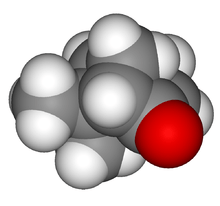Plant communication
Plant communication encompasses all communication between plants and a host of other organisms such as soil microbes,[1] other plants[2] (of the same or other species), animals,[3] insects,[4] and fungi.[5] Plants communicate through a host of volatile organic compounds (VOCs) that can be separated into four broad categories, each the product of distinct chemical pathways: fatty acid derivatives, phenylpropanoids/benzenoids, amino acid derivatives, and terpenoids.[6] Due to the physical/chemical constraints most VOCs are of low molecular mass (< 300 Da), are hydrophobic, and have high vapor pressures.[7] The responses of organisms to plant emitted VOCs varies from attracting the predator of a specific herbivore to reduce mechanical damage inflicted on the plant [4] to the induction of chemical defenses of a neighboring plant before it is being attacked.[8] In addition, the host of VOCs emitted varies from plant to plant, where for example, the Venus Fly Trap can emit VOCs to specifically target and attract starved prey.[9] While these VOCs typically lead to an increase in herbivory resistance in neighboring plants, there is no clear benefit to the emitting plant in helping nearby plants. As such, whether neighboring plants have evolved the capability to "eavesdrop" or whether there is an unknown tradeoff occurring is subject to much scientific debate.[10]
Terpenoids
Terpenoids facilitate communication between plants and insects, mammals, fungi, microorganisms, and other plants.[12] Terpenoids may act as both attractants and repllants for various insects. For example, pine shoot beetles (Tomicus piniperda) are attracted to certain monoterpenes ( (+/-)-a-pinene, (+)-3-carene and terpinolene) produced by Scots pines (Pinus sylvestris), while being repelled by others (such as verbenone).[13]
Terpenoids are a large family of biological molecules with over 22,000 compounds.[14] Terpenoids are similar to terpenes in their carbon skeleton but unlike terpenes contain functional groups. The structure of terpenoids is described by the biogenetic isoprene rule which states that terpenoids can be thought of being made of isoprenoid subunits, arranged either regularly or irregularly.[15] The biosynthesis of terpenoids occurs via the methylerythritol phosphate (MEP) and mevalonic acid(MVA) pathways[6] both of which include isopentenyl diphosphate (IPP) and dimethylallyl diphosphate (DMAPP) as key compenents.[16] The MEP pathway produces hemiterpenes, monoterpenes, diterpenes, and volatile carotenoid derivatives while the MVA pathway produces sesquiterpenes.[6]
References
- ↑ Wenke, Katrin; Kai, Marco; Piechulla, Birgit (2010-02-01). "Belowground volatiles facilitate interactions between plant roots and soil organisms". Planta. 231 (3): 499–506. doi:10.1007/s00425-009-1076-2.
- ↑ Yoneya, Kinuyo; Takabayashi, Junji (2014-01-01). "Plant–plant communication mediated by airborne signals: ecological and plant physiological perspectives". Plant Biotechnology. 31 (5): 409–416. doi:10.5511/plantbiotechnology.14.0827a.
- ↑ Leonard, Anne S.; Francis, Jacob S. (2017-04-01). "Plant–animal communication: past, present and future". Evolutionary Ecology. 31 (2): 143–151. doi:10.1007/s10682-017-9884-5.
- 1 2 De Moraes, C. M.; Lewis, W. J.; Paré, P. W.; Alborn, H. T.; Tumlinson, J. H. "Herbivore-infested plants selectively attract parasitoids". Nature. 393 (6685): 570–573. doi:10.1038/31219.
- ↑ Bonfante, Paola; Genre, Andrea. "Arbuscular mycorrhizal dialogues: do you speak 'plantish' or 'fungish'?". Trends in Plant Science. 20 (3): 150–154. doi:10.1016/j.tplants.2014.12.002.
- 1 2 3 Dudareva, Natalia (April 2013). "Biosynthesis, function and metabolic engineering of plant volatile organic compounds". New Phytologist. 198: 16–32.
- ↑ Rohrbeck, D.; Buss, D.; Effmert, U.; Piechulla, B. (2006-09-01). "Localization of Methyl Benzoate Synthesis and Emission in Stephanotis floribunda and Nicotiana suaveolens Flowers". Plant Biology. 8 (5): 615–626. doi:10.1055/s-2006-924076.
- ↑ Baldwin, Jan T., and Jack C. Schultz. “Rapid Changes in Tree Leaf Chemistry Induced by Damage: Evidence for Communication between Plants.” Science, vol. 221, no. 4607, 1983, pp. 277–279., www.jstor.org/stable/1691120.
- ↑ Hedrich, Rainer; Neher, Erwin (2018-03). "Venus Flytrap: How an Excitable, Carnivorous Plant Works" (PDF). Trends in Plant Science. 23 (3): 220–234. doi:10.1016/j.tplants.2017.12.004. ISSN 1360-1385. Check date values in:
|date=(help) - ↑ "Explaining evolution of plant communication by airborne signals". Trends in Ecology & Evolution. 25 (3): 137–144. 2010-03-01. doi:10.1016/j.tree.2009.09.010. ISSN 0169-5347.
- ↑ Mafra-Neto, Agenor; de Lame, Frédérique M.; Fettig, Christopher J.; Perring, Thomas M.; Stelinski, Lukasz L.; Stoltman, Lyndsie L.; Mafra, Leandro E. J.; Borges, Rafael; Vargas, Roger I. (2013). "Manipulation of Insect Behavior with Specialized Pheromone and Lure Application Technology (SPLAT®)". In John Beck; Joel Coats; Stephen Duke; Marja Koivunen. Natural Products for Pest Management. 1141. American Chemical Society. pp. 31–58.
- ↑ Llusià, Joan; Estiarte, Marc; Peñuelas, Josep (1996). "Terpenoids and plant communication". Bull. Inst. Cat. Hist. Nat. 64: 125–133.
- ↑ Byers, J. A.; Lanne, B. S.; Löfqvist, J. (1989-05-01). "Host tree unsuitability recognized by pine shoot beetles in flight". Experientia. 45 (5): 489–492. doi:10.1007/BF01952042. ISSN 0014-4754.
- ↑ Hill, Ruaraidh; Connolly, J.D. (1991). Dictionary of terpenoids. Chapman & Hall. ISBN 041225770X. OCLC 497430488. Check date values in:
|year= / |date= mismatch(help) - ↑ Ružička, Leopold (1953). "The isoprene rule and the biogenesis of terpenic compounds". Cellular and Molecular Life Sciences. 9 (10): 357–367. doi:10.1007/BF02167631.
- ↑ McGarvey, Douglas J.; Croteau, Rodney (July 1995). "Terpenoid Metabolism". The Plant Cell. 7: 1015–1026. JSTOR 3870054.
